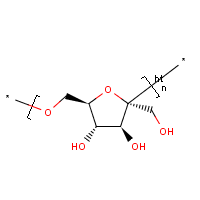
| |
| Names | |
|---|---|
| Other names
Polyfructose
| |
| Identifiers | |
| ChEBI | |
| ChemSpider | |
Except where otherwise noted, data are given for materials in their standard state (at 25 °C [77 °F], 100 kPa).
| |


Levan is a naturally occurring fructan present in many plants and microorganisms.[1] This polymer is made up of fructose, a monosaccharide sugar, connected by 2,6 beta glycosidic linkages. Levan can have both branched and linear structures of relatively low molecular weight.[2] Branched levan forms a very small, sphere-like structure[3] with basal chains 9 units long. The 2,1 branching allows methyl ethers to form and create a spherical shape. The ends of levan also tend to contain a glucosyl residue.[4] Branched levan tends to be more stable than linear polysaccharides.[5] However, the amount of branching and length of polymerization tends to vary among different species.[4] The shortest levan is 6-kestose, a chain of two fructose molecules and a terminal glucose molecule.
- ^ Meyer, Diederick (2015-01-01), Henry, Jeyakumar (ed.), "Chapter Two - Health Benefits of Prebiotic Fibers", Advances in Food and Nutrition Research, 74, Academic Press: 47–91, doi:10.1016/bs.afnr.2014.11.002, PMID 25624035, retrieved 2020-05-10
- ^ Gehatia, M.; Feingold, D. S. (1957-02-01). "The structure and properties of levan, a polymer of D‐fructose produced by cultures and cell‐free extracts of aerobacter levanicum". Journal of Polymer Science. 23 (104): 783–790. Bibcode:1957JPoSc..23..783F. doi:10.1002/pol.1957.1202310421. ISSN 1542-6238.
- ^ Arvidson, Sara A.; Rinehart, B.Todd; Gadala-Maria, Francis (July 2006). "Concentration regimes of solutions of levan polysaccharide from Bacillus sp". Carbohydrate Polymers. 65 (2): 144–149. doi:10.1016/j.carbpol.2005.12.039. ISSN 0144-8617.
- ^ a b Srikanth, Rapala; Reddy, Chinta H S S Sundhar; Siddartha, Gudimalla; Ramaiah, M. Janaki; Uppuluri, Kiran Babu (April 2015). "Review on production, characterization and applications of microbial levan". Carbohydrate Polymers. 120: 102–114. doi:10.1016/j.carbpol.2014.12.003. ISSN 0144-8617. PMID 25662693.
- ^ Öner, Ebru Toksoy; Hernández, Lázaro; Combie, Joan (September 2016). "Review of Levan polysaccharide: From a century of past experiences to future prospects". Biotechnology Advances. 34 (5): 827–844. doi:10.1016/j.biotechadv.2016.05.002. ISSN 0734-9750. PMID 27178733.